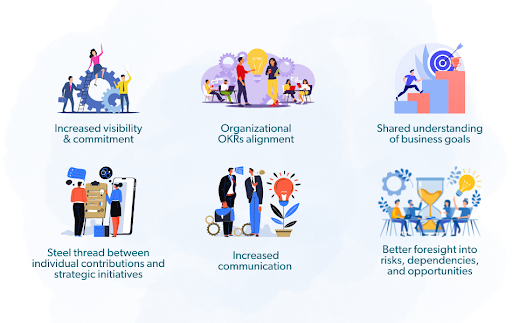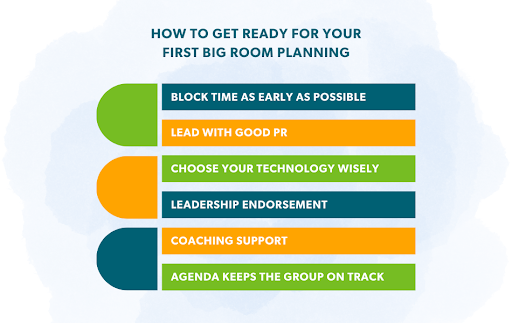Improve your Marketing Ops every week
Subscribe to our blog to get insights sent directly to your inbox.
Confront your process problems head on with a Sherpa by your side.
Explore support options that are tailored to meet you wherever you are on your climb.
Browse our pioneering Agile marketing courses
Learn from the stories of marketers already on the road to process improvement.
Featured Resource

State of Agile Marketing
Learn from 8 years of study on how marketers are increasing their agility.
Download Report
If you’re scaling Agile ways of working across several teams in your organization, you’ll inevitably come up against the challenge of bringing them together in an Agile quarterly planning meeting.
Affectionately referred to as Big Room Planning, or simply BRP, (because we usually need a bigger space if we’re doing so in-person), this quarterly planning moment is the expanded, far-reaching cousin of backlog refinement.
Big Room Planning meetings bring teams that collaborate with each other together for 1-2 days to plan the upcoming quarter at a high level, set expectations with stakeholders, identify and mitigate risks, as well as flag capacity issues, if any are discovered. We've seen it implemented very successfully at everything from large HLS marketing teams to smaller startups. So wherever you are on that scale, it's a planning structure you should consider.
Thinking about bringing this planning session into your organizational calendar for the next quarter? Discover the benefits of this quarterly planning session and some essential tips for making your first one a raging success.

We could write an entire article just listing the many benefits of hosting a Big Room Planning session each quarter inside your organization. But you should at least be aware of some obvious benefits that become immediately apparent when you’ve got such a varied group of attendees coming together to plan like:
But there are also less obvious benefits that might become apparent over time, like:
Big Room Planning is like an elevated Sprint Planning and Backlog Refinement meeting all bundled together and make both of those touchpoints far easier throughout the quarter.
Now that you’ve seen the myriad benefits of BRP, it’s time to learn how to prepare and conduct one.
For all intents and purposes, your first Big Room Planning meeting is bound to be a little bumpy. Partly because it’s your first one, but also because your teams are not used to having the conversations that this meeting creates space for.
Based on our experience leading organizations through their first Big Room Planning meetings, either in-person or virtually, we’ve identified the most important elements you need to have in place for a successful event. If you’re looking to build this quarterly planning cadence into your new Agile organization, keep reading for ways to make sure your first one achieves impactful outcomes.

It might read like a no brainer, but let’s start with a quick win that will keep people positive about the fact they’ll spend 1-2 days of valuable working time on planning, as well as ensuring they actually attend.
If you want the right people in the room, block their calendars as early as you possibly can.
Teams and stakeholders that don’t see quarterly planning coming in their calendars will book other meetings that they’ll need to step out for and disrupt the planning process.
Instead, by scheduling your four Big Room Planning sessions in the calendar at the start of the year, all of your VIPs on the invite will anticipate the events and be better prepared to dedicate the full attention this meeting deserves. It’s also a clear signal that these sessions are important and to be taken seriously.
For those members of your organization who’ve never taken part in a Big Room Planning meeting before, you’ll need to do some education using the right verbiage to get them on board with the idea.
Sending out a monthly Agile newsletter can help you ease team members into the idea of planning quarterly (rather than annually or when a project rolls around, as they might be used to) and give them vital tips on how they can prepare for the events.
Spending so much time up front planning for the quarter might appear unseemly for some team members coming from more traditional organizational hierarchies, where less frequent, annual plans are more common.
Prove to everyone that BRP is worth the time you’ll spend in it by giving this invaluable quarterly touchpoint the good PR it needs to become something people truly look forward to and prepare for.
There’s a case to be made for both virtual and in-person Agile quarterly planning meetings. Virtual planning tends to stay on track more easily, but in-person planning is more engaging for attendees.
However, in both cases, technology can be helpful in effectively documenting the outcomes of discussions that take place throughout the day. Visualization tools, in particular, can ensure that teams don’t lose track of action items, priority changes, or other shifts that they agree on throughout the day.
Big Room Planning meetings that run on post-its and Sharpies are not out of the question as they also help with visualization. But, the ease of translating digital notes into another digital task management tool like Jira or Workfront can’t be beat.
Consider digital visualization tools, like Miro or Mural, to support your next quarterly planning meeting by capturing all your team’s conversations in one consolidated place.
We’ve participated in Big Room Planning sessions that were kicked off by Agile coaches, team leaders, and C-suite/VP level leaders. Based on our observations, nothing quite instigates excitement like hearing a C-level executive or Vice President being supportive of the fact that this group has come together to plan ahead.
Hearing words of encouragement from organizational leaders that team members don’t usually have direct access to can be very motivating.
Of course, BRPs can still succeed with a kick off from a departmental or team leader or an Agile coach. But if you’re able to get a 30 minute speech from someone the teams rarely engage with, but look up to, it can make all the difference to the energy in the room.
Your first Big Room Planning stands to gain a lot from expert facilitation and moderation. We might sound biased when we say this, but we’ve heard about many such forums derailing because the teams in the breakout rooms have too many open questions as they plan ahead for the quarter.
Leaders have a huge role to play in Big Room Planning. They set the stage, clarify strategy, and keep team spirits high.
That is exactly why they need trusted partners who can lead the individual working groups towards the desired outcomes from this meeting in a streamlined and efficient way.
Playing a BRP by ear is a recipe for disaster. Time tends to go by quickly when you gather all of your key stakeholders and core team members in a room and start planning the next several months of work.
Make sure you’re not wasting anyone’s precious time by carefully curating an agenda ahead of the meeting and socializing it with the group of potential attendees. From our experience, these agendas bear a few rounds of iterations before they fully reflect the goals of the meeting and account for every piece of the puzzle that needs to come together.
Give yourself time to change and improve it before sharing it with the group. An example agenda for Day 1 of Big Room Planning might look something like this:
|
Time |
Duration |
Topic |
Teams involved |
Goal |
|
9:00-9:30 |
30 min |
Kick-Off Overview |
All teams |
Reminder of Leadership OKRs and BRP goals |
|
9:30-12:00 |
2.5 hours |
Team Project Request Prioritization Session |
Team Breakouts |
Lay out Q1 projects in a visual board, prioritize the projects by month in order of importance and OKRs, note initial capacity risks |
|
12:00-12:45 |
45 min |
LUNCH/BREAK |
||
|
12:45-1:15 |
30 min |
Confirm Team Priority of Q1 work |
Team Breakouts |
Finalize team level prioritization for shared service team review |
|
1:15-2:00 |
45 min |
Rotation 1 w/ Shared Service |
See rotation guide |
See rotation guide |
|
2:00-2:15 |
15 min |
BREAK |
||
|
2:15-3:00 |
45 min |
Rotation 2 w/ Shared Service |
See rotation guide |
See rotation guide |
|
3:00-3:10 |
10 min |
TRANSITION |
||
|
3:10-3:55 |
45 min |
Rotation 3 w/ Shared Service |
See rotation guide |
See rotation guide |
|
3:55-4:00 |
5 min |
Day 1 Debrief |
Department Leaders, Agile Leads, Agile Coaches/Scrum Masters |
Check on progress of each team and decide if any schedule adjustments are needed for Day 2 |
Before proceeding to learn the next tip, why don't you take a second to get our Agile Marketing Transformation Checklist?
Although the assumption is that all teams participating in Big Room Planning have likely participated in Agile training and already have some experience with Agile practices, reviewing vital concepts at the start of BRP can help them consider the work through the right lens.
To kick off an Agile quarterly planning meeting, it’s worth reinforcing the importance of the following:
Making sure everyone kicks off with the same understanding of these pillars sets the stage for a successful series of discussions with the right common perspective.
Many a Big Room Planning meeting has been derailed by a lack of clear direction for the teams.
Much of the time your teams spend in this meeting will be spent in workshops with their core team members before they present out to the wider group. Ensure the time in breakouts is spent meaningfully by providing helpful guidance in the form of a checklist to help the team navigate what is expected of them.
Checklists for Big Room Planning responsibilities from the team side while in breakouts might include:
Ending your quarterly planning meeting with a retrospective to collect feedback from the events of the previous quarter is a great technique to reinforce your commitment to the Agile way of working. The retrospective format invites input from the group of team members you’ve gathered and can surface critical action items to improve the next iteration of your joint process.

Appropriate retrospective templates to use to wrap your Big Room Planning meeting include:
Whether you’re running the post-BRP retrospective in-person or virtually, having a skilled facilitator to lead the group through some of the thornier topics can be an advantage.
The action items generated by the retrospective can be added to the leadership backlog for the upcoming quarter.
Get ready for a lot of excited faces at the end of this 1-2 day event. By the end of the Big Room Planning agenda, everyone will have already understood the benefits of getting together. Hopefully, they will have also shared their feedback about what is and isn’t possible in the upcoming quarter as well as raised some potential risks to watch out for.
It’s up to leaders to send a recap and push action items from the Big Room Planning retrospective to resolution in the coming weeks.
Keep the momentum of this crucial touchpoint and show your teams that the takeaways from this 1-2 day event were taken seriously and used for continuous improvement purposes on the organizational level. For example, if you find that your teams are consistently getting bogged down with unplanned work that wasn't accounted for in the Big Room Planning, you may want to adjust your process.
When your first Big Room Planning goes right, you’ll reap the benefits of this throughout the entire quarter on the team and leadership levels.
To make sure you nail your first one, follow the tips in this article and don’t hesitate to reach out to our team to hear about more ways to infuse your quarterly planning with even more team spirit and positive outcomes.
As you can probably tell, these best practices don’t apply to your first such meeting alone. In fact, they can be applied to every large-scale planning that you undertake, no matter how often you are used to hosting it.
If you’re looking for a coach to help you facilitate your scaled retrospective or moderate your team breakout sessions – get in touch!
Also, be sure to frequently upgrade your Agile knowledge and don't let being busy prevent you from reaching your full potential individually and as a team.
To help you do so even in the busiest of times, we developed a library of content based on years of working with Agile marketing teams, and broken it down into 4 microlearning paths for different contexts:
Each of them contains 10 bite-sized lessons, 20 short engaging videos, and 10+ downloadable resources that can boost your Agile knowledge in minutes even during the busiest days.
And before you move on, don't forget to get your copy of our Agile Marketing Transformation Checklist.
Subscribe to our blog to get insights sent directly to your inbox.
Subscribe to our blog to get insights sent directly to your inbox.